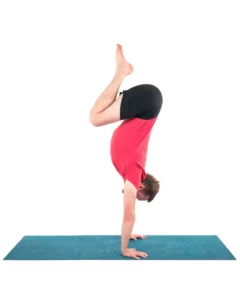2 Wrist-Friendly Variations of Plank Pose

Article At A Glance
Plank Pose (Phalakasana) is a fantastic way to build core and upper body strength in yoga practice. But the pose can be challenging for wrists and hands. The good news is that variations can provide the core-building benefits of the pose without compromising your wrists.
Plank Pose (Phalakasana) is a very common pose that can be a fantastic way to build core and upper body strength in yoga practice. Plank Pose can also challenge wrists and new yoga practitioners, so variations are important. The following variations give the opportunity to strengthen the core and shoulders without stressing the wrists.
The Cobra Variation of Plank Pose

Pose Benefits:
- Strengthens the serratus anterior
- Strengthens shoulder stabilizing muscles
- Gentle spinal extension
- Cultivates body awareness
How to Practice the Cobra Plank Pose Variation

- Start lying on your belly, and make sure there is room in front of you on the mat for your arms.
- Reach your arms overhead, on the mat, and bend your elbows so your arms resemble a diamond shape. Check that your elbows roughly line up with your eyebrows when your forehead is on the mat.
- Inhale and gently rest the forehead on the mat and ground the elbows, forearms, and hands.
- Exhaling, press the forearms into the mat. Imagine you’re trying to push them to the front of the mat.
- As you press the forearms, the chest will lift off the ground; keep the neck long as you lift.
- Hold for 5 to 10 breaths then release the upper body back down.
Practice Tips for Cobra Plank Pose Variation
- Make sure the elbows stay out in front of the shoulders.
- Focus on the engagement around the shoulders rather than lifting the chest high.
- Gaze down your nose to resist the temptation to over-extend the neck.
The Full-Lift Plank Pose Variation

This variation requires a lot more core strength. It’s important to understand that even though you may not lift off the ground, the attempt is enough to access the many benefits.
Benefits of this Pose
- Creates strength in shoulder stabilizer muscles, particularly the serratus anterior
- Builds core strength
- Builds upper body strength
- Builds body awareness and confidence
How to Practice the Full-Lift Plank Pose Variation
- Start in the same position as the previous variation, on the belly with arms in a diamond overhead.
- Bend your right knee and turn your leg out so the inner thigh, knee, inner lower leg, and foot are on the mat. It will look a little like Half-Bound Angle Pose (Ardha Baddhakonasana).
- Inhale, tuck the long leg toes under, keep the bent knee lower leg on the ground.
- Exhale, press into the forearms and engage the core to lift the whole torso off the ground.
- Keep the body in one long line from shoulders to long-leg foot as you lift.
- Hold the pose for 5 to 10 breaths, then release to the mat.
- Repeat with the left leg bent and the right leg straight.
Practice Tips for Full-Lift Plank Pose Variation
- Press into the bent leg knee to help you lift.
- Keep your neck long, gaze down the nose rather than hyper-extending the neck.
- Focus on keeping the body long.
- Resist the temptation to bring the elbows underneath the shoulders. I know it’s easier that way, but that’s a different pose.
- Focus on the activation to lift rather than the height the body lifts.
Also, read...
Teaching Svadhyaya: 3 Ways to Encourage Self-Study in Yoga
In Celebration of Gray-Haired Yoga – Busting the Myth of the Yoga Body
Related courses

Erin Bourne (RYT500, YACEP) is a yoga teacher and yoga teacher trainer based in Seventeen Seventy (yes, the real town name) in Australia. She also teaches Pilates and other movement modalities; having come to yoga from an Exercise Science and education background, she is obsessed with learning and sharing about the body and movement. Erin shares her experience and knowledge through regular classes, teacher trainings, online courses, and writing. Her course offerings include 3D Anatomy and Resistance Yoga. Her writing includes the book A Yogi’s Guide to Fascia and numerous print and online published articles. You can find Erin’s creations through her website http://www.erinlbourne.com/



